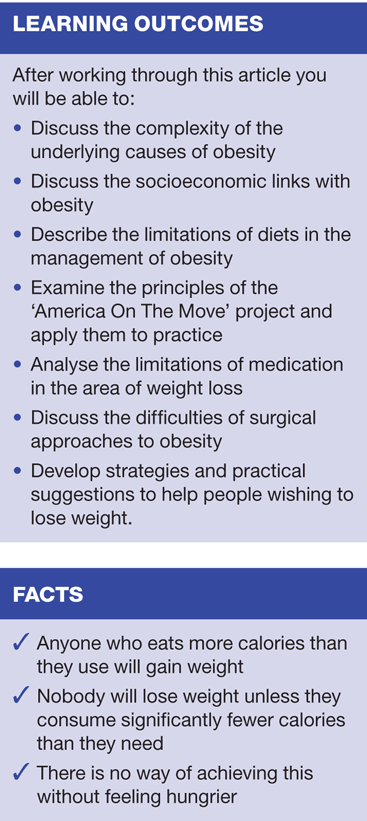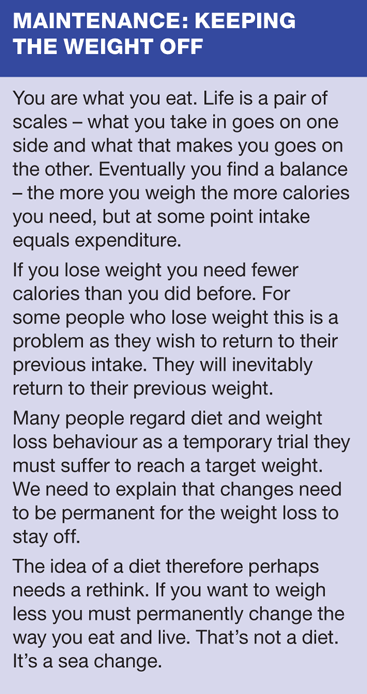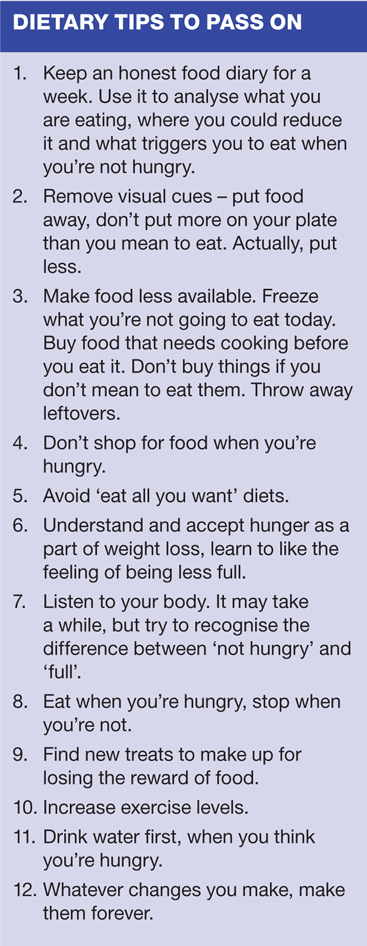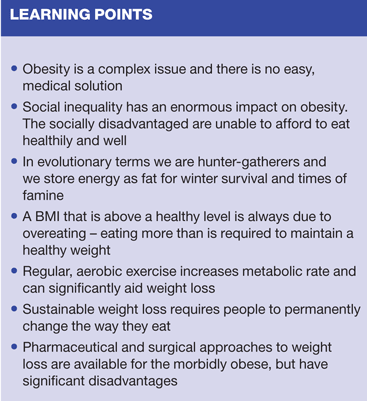Obesity and the Practice Nurse
Dr Mary Lowth
Dr Mary Lowth
GP Locum North London and MRCGP Examiner
Practice nurses are at the forefront of the need to curb the national epidemic of obesity but are frequently faced by patients despondent at their failure to lose weight and angry at our failure to offer an easy and effective solution. This article examines the problems, and what we can offer
The need for concern at the increasing body mass index (BMI) of people in the developed world cannot be overestimated, both in terms of health care budgets and the risk to the health of people who are overweight. The causes of obesity are complex.1 The solutions ought to be simple: eat less and more healthily, exercise more"¦ and bingo, everyone's a winner! Unfortunately it isn't that easy. The causes of obesity are far more complex than greed and ignorance and there is no easy, medical cure.
THE BIOLOGICAL MODEL OF OBESITY
Throughout evolution the human race has been more at risk from starvation than from overeating. Fat is money in nature's bank and we have evolved efficient processes for storing it. We are hunter-gatherers and we store energy for famine and winter survival. Just as squirrels store nuts in holes in the ground, we store energy as fat — on our hips.
Overeating is an emotive word for people who are obese. The plain fact is that those who are obese, overeat. They may feel they eat frugally, yet, in medical terms, what you eat maintains your body weight. If you are above a healthy BMI then you are overeating. It is that simple.
If you lead a very sedentary life and happen to have a low metabolic rate then it doesn't take much to overeat. Most of America's excess pounds are acquired through overeating by less than 100 calories a day.2,3 Nevertheless, obese people consistently underestimate the amount they eat.4
HUNGER AND SATIETY
In our modern world we are fighting nature. Why is it, then, that some people manage to remain slim all their lives, and others don't?
One possible answer lies in the difference between satiety and hunger. These are controlled by two separate areas in the brain. Slim people eat until they reach satiety but do not eat again until they feel hunger. Obese people eat to maintain satiety, but this is only part of the story. Brain signals are overridden by many things, including the pleasure of food, emotional drivers, habit, social obligations and boredom. People eat because it's nice, because it makes them feel better, because they don't feel loved, because it displaces negative emotions, because everyone else is eating, because food is there and diverts them from less pleasant tasks. They eat because food is a reward.
CHOICE, ACCESSIBILITY AND EXTERNAL CUES
One of the drivers to overeating is the variety and easy availability of food. In cultures where the diet offers little choice there is little pleasure in eating, other than to satisfy hunger. Moreover in situations where one cannot eat until one has worked to produce the food it is not nearly so easy to overeat or eat on impulse.
This offers us some strategies for weight loss, such as reducing temptation. Avoid buying cakes and biscuits. Freeze bread the moment you get home, keeping out only what you need for the next meal. Throw away leftovers on plates unless you need to save them. They are better in the bin than around your waist.
Experiments to prove the 'internal-external' theory of hunger5 demonstrated that obese people respond to external food cues more than non-obese people, who tend to respond to internal cues of hunger. This offers us another strategy. It may help to put food away, make it less prominent, and avoid thinking about it and planning it, all of which has been found to disproportionately stimulate hunger in the obese.
Diets that involve too much thought about food can be counterproductive. In practical terms, a dietary regime that does NOT involve dietary planning is likely to be more successful. Keep it simple so that it needs no thought. Skip dessert or always have an apple.
OBESITY AND SOCIAL CLASS
The impact of social inequalities on obesity is huge.1 This is a strange reversal of the situation 200 years ago, when the poor were starving and the rich were fat. In truth the poor are still starving, but starved of access to good healthy food and the means to eat well.
Other things contribute to this inequality — lack of education, lack of self-esteem and lack of access to other reward systems. In Glasgow's East End, where life expectancy is around 60 years, people are on benefits, living from week to week, relying on convenience foods. Mothers know fat and crisps are bad for children but they can't afford alternatives.
Too much of a good thing
A diet may be healthy in content but not healthy in quantity. You can become overweight on fruit alone if you eat enough of it.
DIETS
Many diets are attempts to lose weight without feeling hungry, loading people with high volumes of low calorie foods. Some diets restrict food types so much that people become bored and don't want any more, but the body is cleverer than this.
The body can feel hungry even when the stomach is stretched to capacity by bulking agents. The body can crave only buttered bread even though it's being offered all the steak it can eat. Hunger is not easily suppressed and such diets may turn the mind to food even more than usual, something which is usually counterproductive.
METABOLIC RATES
We all have different metabolic rates, affected by factors such as genetics, weight, exercise, anxiety, and timing of meals.
Obese people may indeed have a lower metabolic rate than others. All that matters though is whether they, personally, consume more calories than they burn. If so they are eating too much.
Regular aerobic exercise will increase metabolic rate, not only while exercising but for a prolonged time afterwards. Morning exercise is particularly useful as it increases metabolic rate for the whole day. There is some evidence that moderate aerobic exercise suppresses appetite — or at least does not increase it.
Metabolic rate is also increased by having breakfast. If the body gets breakfast it knows it's not going to be starved today, so the metabolic rate increases, energy levels are better and the day starts well.
The diet tips that arise from these factors are:
1. Eat a good breakfast, with some slow release carbohydrate
2. Avoid starving through the day. The body will cut your metabolic rate and subject you to huge and possibly irresistible surges of hunger around teatime.
3. Exercise for 20—30 minutes at least three times a week. You'll not only feel better, you'll be able to eat more and STILL lose weight.
DAILY DIETS
Many people work on a daily basis, starting each day afresh. Yet if you eat more one day because you've been out for a celebratory meal, then you may need less the next day. And if you starve for a day as a 'detox' you will be very hungry the next day.
When trying to lose weight, an even daily intake will avoid these highs and lows.
ENTITLEMENT AND REWARD
People often say:
'I can't be expected to eat less than this'.
This exemplifies the emotional and physical pleasure people get from food. People eat because they like it, it comforts them, it makes them feel better. They feel threatened and angry at the thought they may have to lose this. They behave in a childlike way, treating you as the parent who plans to withhold life's pleasures.
The answer to this situation is to offer understanding yet step away from that parent-child interaction. Needing less food is not a tragedy for anyone, but we all recognise that the pleasures of food are about more than solving hunger.
First, challenge the statement. Remind them that nobody expects anything. If they want to lose weight this will involve sacrificing some of the enjoyment they get from food.
Secondly, understand. Explain that removing a source of pleasure and happiness is hard — they need to find another source of pleasure and happiness to replace it. Find other treats. Food treats are probably best avoided, even though many diets use this approach, as they 'feed' the very problem they are trying to solve. Treats such as watching a film, a hot bath, listening to music, putting saved food money into a pot and buying toiletries, are all food free treats which may help address the internal reward systems that otherwise promote obesity.
HUNGER AND THIRST
Some people eat because they are thirsty. Suggest that when they feel hungry they try a drink of water first. Then try to wait twenty minutes to give this a chance to take effect.
Avoid drinks which use sweeteners to deceive the body into thinking it is receiving sugar — such drinks probably maintain the 'sweet tooth' that is the enemy of weight loss.
DON'T BE A HUMAN HOOVER
There's a bin in your kitchen. Use it! Eat food that's worth eating. Would you rather have something you enjoy or the last bit of your baby daughter's mashed beans and potato?
If it's not your lunch, throw it away. It's just as wasted if it goes straight to your waistline. The other tip is to be quick. Scrape the plates before they can tempt you. And if you must save it, freeze it.
OTHER APPROACHES
1. America on the move: 2000 steps 100 calories2
This US public health measure followed the realisation that the bulk of America's increasing weight problem could be attributed to daily excess consumption of 100 calories or less. Participants are encouraged to buy a pedometer, then eat 100 calories less each day and walk an extra 2000 steps. The programme has been successful in reducing the steady gain in BMI.
2. Support groups
Weight reduction groups operate through a mixture of offering healthy diet and lifestyle advice and various forms of buddying. They use positive reinforcement (public weighing) to drive good behaviour, but when weight is not lost this approach can be problematic.
Some experts think that the group approach focuses too much on weight rather than health, but groups differ and this approach suits many individuals. There is, however, evidence that many who manage weight loss this way do not sustain it once they leave the group and the support and positive reinforcement is lost.
3. Liquid and replacement diets
A variety of meal replacement diets have shown success in some people. These often involve the replacement of the normal diet partially or completely by programme food, often liquid. If patients can manage the discipline of this they can show dramatic success.
These diets win because they are simple, they take the decision making out of the diet and stop the patient thinking about food. The rewards of food — pleasure, choice — are also taken away.
It will be no surprise to you that this approach may work initially, but will typically fall down on sustainability.6
4. Other diets
A variety of weight loss diets fill the shelves of newsagents and bookstores. After reading this article you may be better placed to evaluate the usefulness of these individually.
Many aim to trick the body into satiety — which works temporarily, if at all. Others work through restriction of food types. Eventually the body tends to crave what is missing and not what is on offer. There is also a risk with diets that cut out one food type that essential nutrients may be missing in the long term.
WHICH DIET?
We are complex individuals. For each of us the mixture of socioeconomic conditions, occupation, appetite, emotion, metabolism, socialisation and susceptibility to food are different. Different diets work at different points in this network of cause and effect, and for every diet there will be some people for whom it fits the bill. However, one size definitely does not fit all, and anything that is not sustainable in the long term is ultimately, not sustainable.
DRUGS AND DISASTERS
Drugs come towards the end of this article as they have little to do with successful weight management. Many drugs have come and gone. Most have been withdrawn on safety grounds. Only orlistat currently remains.
Orlistat works by preventing the absorption of fat from the intestine and can only be prescribed to patients with a high BMI and a demonstrated ability to cut down their fat intake.
Orlistat only works in patients who have a high proportion of fat in their current diet, which they are prepared to cut out. If they don't, the drug will give them unpleasant oily diarrhoea. Many doctors argue that if patients can cut out the fat then they should do so without the orlistat — and if they can't, they won't be able to tolerate it. Orlistat has its supporters, but evidence does not support it as an agent for long-term sustainable weight change.
SURGICAL OPTIONS
There are a variety of surgical interventions to manage obesity.7 All work on the same principle — to reduce the capacity and absorbing power of the stomach.
Current restrictions on NHS funding mean that surgical treatments for obesity are available to very few patients. In most areas a BMI of 40 or even 50 is necessary before funding can even be considered, and there are further major hurdles in terms of psychological assessment. Not all are able to cope with the physical sequelae of reduced stomach capacity, for these treatments are unpleasant to live with. They don't remove central hunger, but severely restrict the ability to eat. They may work — but they are not an easy option.
CONCLUSION
Obesity is a growing problem that places a great burden on both health and healthcare. There are no quick fix interventions, and the causes are complex. Support, counseling, advice and a '2000 steps 100 calories' approach are a start, but many public health doctors would say that whilst the consequences of obesity are obviously medical, the problem itself is sociopolitical and the solutions lie in jobs, a decent wage, regeneration of impoverished areas and individual empowerment.
REFERENCES
1. Marsh P. Poverty and obesity. Social Issues Research Centre. 2004 http://www.sirc.org/articles/poverty_and_obesity.shtml
2. America on the move https://aom3.americaonthemove.org/
3. Hill JO, Wyatt HR, Reed GW, Peters JC. Obesity and the Environment: Where Do We Go from Here? Science 2003; 299 (5608): 853-855
4. Young LR Nestle M. Portion sizes in dietary assessment: issues and policy implications: Nut Rev 1995: 53; 149-58
5. Schachter S. Emotion, Obesity, and Crime. New York: Academic Press 1971
6. Maclean PS, Bergouignan A, Cornier MA, Jackman MR. Biology's response to dieting: the impetus for weight regain. Am J Physiol Regul Integr Comp Physiol. 2011 301(3):R581-600.
7. National Institute for Health and Care Excellence. The prevention, identification, assessment and management of overweight and obesity in adults and children. CG43 2006 www.nice.org.uk/CG43
Related articles
View all Articles





